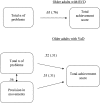Inhibitory Control, Task/Rule Switching, and Cognitive Planning in Vascular Dementia: Are There Any Differences From Vascular Aging?
- PMID: 30410439
- PMCID: PMC6211074
- DOI: 10.3389/fnagi.2018.00330
Inhibitory Control, Task/Rule Switching, and Cognitive Planning in Vascular Dementia: Are There Any Differences From Vascular Aging?
Abstract
Recent studies have shown that patients diagnosed with Vascular Dementia (VaD) exhibit deficits in executive functions. According to "vascular hypothesis of cognitive aging," community-dwelling older adults having risk factors for vascular disease development (RVD) may suffer from cognitive decline of the same type. The aim of the study was to assess the level of specific executive functions (EF) that have been revealed as most affected by vascular abnormalities, in older adults with incipient VaD and RVD. Subsequently specific ways of EF measuring could be suggested for more accurate diagnosis of early stage VaD. The study compared three adult groups (N = 60): (a) patients diagnosed with incipient VaD, according to DSM-5 criteria (n = 20); (b) community-dwelling older adults presenting cardiovascular risk factors (RVD; n = 20); (c) healthy young adult controls (n = 20). Three types of executive functions were examined: inhibitory control, cognitive flexibility as rule/task switching, and planning. The following D-KEFS subtests were administered for their evaluation: The 'Color-Word Interference Test,' the 'Verbal Fluency Test,' and the 'Tower Test.' Mixed-measures ANOVA, MANOVA, and one-way ANOVA as well as Scheffe post hoc test were applied to the data of the scores in each condition of each test. The results showed that VaD patients had significantly lower performance in test conditions requiring switching and planning, compared to RVD group and young controls. The specific deficits of VaD patients, compared to older adults presenting RVD according to multiple-group path analyses were: more uncorrected errors in inhibition, the use of semantic knowledge primarily instead of switching ability to switch between semantic categories, as well as a lower level of movement precision in planning.
Keywords: D-KEFS subtests; cold executive functions; early stage vascular dementia; periventricular white matter hyperintensities; vascular hypothesis of cognitive aging.
Figures



Similar articles
-
Self-report instruments of cognitive failures as screening tools for Subjective Cognitive Impairment in older adults.Hell J Nucl Med. 2017 Sep-Dec;20 Suppl:58-70. Hell J Nucl Med. 2017. PMID: 29324915
-
The Relationships of Specific Cognitive Control Abilities with Objective and Subjective Sleep Parameters in Mild Cognitive Impairment: Revealing the Association between Cognitive Planning and Sleep Duration.Brain Sci. 2024 Aug 14;14(8):813. doi: 10.3390/brainsci14080813. Brain Sci. 2024. PMID: 39199504 Free PMC article.
-
Branching Condition of the Color-Word Interference Test Enhances Prediction of Meta-Tasking in Community-Dwelling Older Adults.J Int Neuropsychol Soc. 2021 Nov;27(10):1004-1014. doi: 10.1017/S1355617720001381. Epub 2021 Feb 26. J Int Neuropsychol Soc. 2021. PMID: 33632370
-
Neuropsychological deficits in vascular dementia in relation to Alzheimer's disease: reviewing evidence for functional similarity or divergence.Dementia. 1994 May-Aug;5(3-4):203-9. doi: 10.1159/000106724. Dementia. 1994. PMID: 8087181 Review.
-
Cognitive deficits in bipolar disorders: Implications for emotion.Clin Psychol Rev. 2018 Feb;59:126-136. doi: 10.1016/j.cpr.2017.11.006. Epub 2017 Nov 21. Clin Psychol Rev. 2018. PMID: 29195773 Free PMC article. Review.
Cited by
-
Subcortical Ischemic Vascular Cognitive Impairment: Insights from Reaction Time Measures.J Alzheimers Dis. 2019;72(3):845-857. doi: 10.3233/JAD-190889. J Alzheimers Dis. 2019. PMID: 31594238 Free PMC article.
-
Neuropsychological Assessment for Early Detection and Diagnosis of Dementia: Current Knowledge and New Insights.J Clin Med. 2024 Jun 12;13(12):3442. doi: 10.3390/jcm13123442. J Clin Med. 2024. PMID: 38929971 Free PMC article. Review.
-
R4Alz-Revised: A Tool Able to Strongly Discriminate 'Subjective Cognitive Decline' from Healthy Cognition and 'Minor Neurocognitive Disorder'.Diagnostics (Basel). 2023 Jan 17;13(3):338. doi: 10.3390/diagnostics13030338. Diagnostics (Basel). 2023. PMID: 36766444 Free PMC article.
-
Age-related differences in network controllability are mitigated by redundancy in large-scale brain networks.Commun Biol. 2024 Jun 7;7(1):701. doi: 10.1038/s42003-024-06392-2. Commun Biol. 2024. PMID: 38849512 Free PMC article.
-
Normative Data for the D-KEFS Tower Test in Greek Adult Population Between 20 and 85 Years Old.Brain Sci. 2025 Mar 6;15(3):278. doi: 10.3390/brainsci15030278. Brain Sci. 2025. PMID: 40149799 Free PMC article.
References
-
- American Psychiatric Association (2013). Diagnostic and Statistical Manual of Mental Disorders, 5th Edn. Arlington, VA: American Psychiatric Publishing; 10.1176/appi.books.9780890425596 - DOI
-
- Armstrong R. A., Hilton A. (2006). Post hoc ANOVA tests. Microbiologist 6 34–36.
LinkOut - more resources
Full Text Sources

